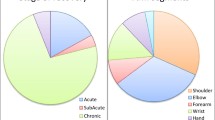Abstract
Robot assisted rehabilitation training is a promising tool for post-stroke patients’ recovery, and some new challenges are imposed on robot design, control, and clinical evaluation. This paper presents a novel upper limb rehabilitation robot that can provide safe and compliant force feedbacks to the patient for the benefits of its stiff and low-inertia parallel structure, highly backdrivable capstan-cable transmission, and impedance control method in the workspace. The “assist-as-needed” (AAN) clinical training principle is implemented through the “virtual tunnel” force field design, the “assistance threshold” strategy, as well as the virtual environment training games, and preliminary clinical results show its effectiveness for motor relearning for both acute and chronic stroke patients, especially for coordinated movements of shoulder and elbow.
Similar content being viewed by others
References
Ouellette M M, LeBrasseur N K, Bean J F, et al. High-intensity resistance training improves muscle strength, selfreported function, and disability in long-term stroke survivors. Stroke, 2004, 35: 1404–1409
Riener R, Nef T, Colombo G. Robot-aided neurorehabilitation of the upper extremities. Med Biol Eng Comput, 2005, 43: 2–10
Marchal-Crespo L, Reinkensmeyer D J. Review of control strategies for robotic movement training after neurologic injury. J Neuro Eng Rehabil, 2009, 6: 20
Peng L, Hou Z G, Wang W Q. Synchronous active interaction control and its implementation for a rehabilitation robot. Acta Autom Sin, 2015, 41: 1837–1846
Reinkensmeyer D J, Wolbrecht E, Bobrow J. A computational model of human-robot load sharing during robot-assisted arm movement training after stroke. In: Proceedings of Annual International Conference of the IEEE Engineering in Medicine and Biology Society (EMBC), Lyon, 2007. 4019–4023
Peng L, Hou Z G, Peng L, et al. Design of CASIA-ARM: a novel rehabilitation robot for upper limbs. In: Proceedings of IEEE/RSJ International Conference on Intelligent Robots and Systems (IROS), Hamburg, 2015. 5611–5616
Minh H V, Joo N U. Tele-operation of a 6-dof serial robot using a new 6-dof haptic interface. In: Proceedings of IEEE International Symposium on Haptic Audio-Visual Environments and Games (HAVE), Phoenix, 2010. 1–6
Buerger S P, Palazzolo J J, Krebs H I, et al. Rehabilitation robotics: adapting robot behavior to suit patient needs and abilities. In: Proceedings of the American Control Conference (ACC), Boston, 2004. 3239–3244
Peng L, Hou Z G, Wang W Q, et al. Dynamic modeling and control of a parallel upper-limb rehabilitation robot. In: Proceedings of IEEE International Conference on Rehabilitation Robotics (ICORR), Singapore, 2015. 532–537
Lo A C, Guarino P D, Richards L G, et al. Robot-assisted therapy for long-term upper-limb impairment after stroke. New Engl J Med, 2010, 362: 1772–1783
Krebs H I, Palazzolo J J, Dipietro L, et al. Rehabilitation robotics: performance-based progressive robot-assisted therapy. Auton Robots, 2003, 15: 7–20
Hogan N. Impedance control: an approach to manipulation. In: Proceedings of American Control Conference (ACC), San Diego, 1984. 304–313
Gil J J, Avello A, Rubio A, et al. Stability analysis of a 1 DOF haptic interface using the Routh-Hurwitz criterion. IEEE Trans Contr Syst Technol, 2004, 12: 583–588
Klamroth-Marganska V, Blanco J, Campen K, et al. Three-dimensional, task-specific robot therapy of the arm after stroke: a multicentre, parallel-group randomised trial. Lancet Neurology, 2014, 13: 159–166
Acknowledgements
This work was supported in part by National Natural Science Foundation of China (Grant Nos. 61533016, 61421004, 61603386, U1613228), Early Career Development Award of SKLMCCS, and Beijing Science and Technology Project (Grant No. Z161100001516004).
Author information
Authors and Affiliations
Corresponding author
Additional information
Conflict of interest The authors declare that they have no conflict of interest.
Supporting information The supporting information is available online at info.scichina.com and link. springer.com. The supporting materials are published as submitted, without typesetting or editing. The responsibility for scientific accuracy and content remains entirely with the authors.
Rights and permissions
About this article
Cite this article
Peng, L., Hou, ZG., Peng, L. et al. Robot assisted rehabilitation of the arm after stroke: prototype design and clinical evaluation. Sci. China Inf. Sci. 60, 073201 (2017). https://doi.org/10.1007/s11432-017-9076-9
Received:
Accepted:
Published:
DOI: https://doi.org/10.1007/s11432-017-9076-9




